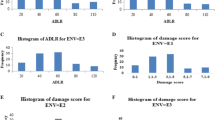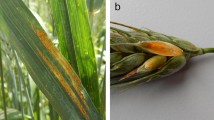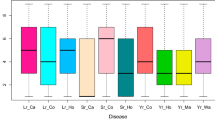Abstract
Rice production faces a significant threat from the rice leaffolder, Cnaphalocrocis medinalis. To address this challenge, growing resistant varieties stands out as a sustainable and eco-friendly pest management strategy. This necessitates identifying resistant sources and understanding their inheritance patterns through employing DNA markers for marker-assisted resistance breeding. Our study involves screening for resistant cultivars following the SES of IRRI, assessing genetic diversity among landraces using molecular markers, and identifying genomic regions associated with resistance. Screening indicated that 33.33%, 27.08%, 19.79%, and 19.80% of genotypes were resistant, moderately resistant, susceptible, and admixture, respectively. Landraces were categorized into three clusters, with clusters I and II predominantly containing moderately resistant and resistant cultivars, and cluster III mainly susceptible types. Molecular variance analysis revealed 12% variation among populations and 88% within the population. Simple linear regression identified significant marker-trait associations, with markers RM 162 and RM 284 on chromosomes 6 and 8, respectively, found highly associated with leaffolder resistance. Phenotypic variation in leaffolder damage correlated highly with the allelic effects of these markers. Further confirmation of marker linkage with resistance loci was established through independent assays on highly resistant and susceptible genotypes. The information derived from genetic diversity and marker-trait associations will be useful for future marker-assisted resistance breeding programs, enhancing the sustainability of rice production.











Similar content being viewed by others
Data availability
The landraces used in the experiment were obtained from Gene Bank, ICAR-NRRI, Cuttack. The details of primers used in the study were retrieved from the Gramene database for comparative analysis. The data supporting the findings of this study are available from the corresponding author upon reasonable request.
References
Akagi H, Inagaki YA, Fujimura T (1997) Highly polymorphic microsatellites of rice consist of AT repeats, and a classification of closely related cultivars with these microsatellite loci. Theor Appl Genet 94:61–67. https://doi.org/10.1007/s001220050382
Chen B, Niu F, Liu WZ, Yang B, Zhang J, Ma J, Cheng H, Han F, Jiang YQ (2016) Identification, cloning and characterization of R2R3-MYB gene family in canola (Brassica napus L.) identify a novel member modulating ROS accumulation and hypersensitive-like cell death. DNA Res 23(2):101–14. https://doi.org/10.1093/dnares/dsv040
Chen JF, Zhao ZX, Li Y, Li TT, Zhu Y, Yang XM, Zhou SX, Wang H, Zhao JQ, Pu M, Feng H (2021) Fine-tuning roles of Osa-miR159a in rice immunity against Magnaporthe oryzae and development. Rice 14(1):26–88. https://doi.org/10.1186/s12284-021-00469-w
Chintalapati P, Katti G, Puskur RR, Nagella Venkata K (2016) Neonicotinoid-induced resurgence of rice leaffolder, Cnaphalocrocis medinalis (Guenee). Pest Manag Sci 72:155–161
Correa-Victoria FJ, Tharreau D, Martinez C, Vales M, EscobarF PG, Aricada G (2002) Gene combinations for durable rice blast (Pyricularia grisea) resistance in Colombia. Fitopatol Colomb 26:47–55
Divya B, Robin S, Rabindran R, Senthil S, Raveendran M, Joel AJ (2014) Marker assisted backcross breeding approach to improve blast resistance in Indian rice (Oryza sativa) variety ADT43. Euphytica 200:61–77. https://doi.org/10.1007/s10681-014-1146-9
Duan XL, Peng X, Qiao XF, Chen MH (2017) Life cycle and population genetics of bird cherry-oat aphids Rhopalosiphum padi(L.) (Hemiptera: aphididae) in China: an important pest on wheat crops. J Pest Sci 90:103–116. https://doi.org/10.1007/s10340-016-0752-9
Earl DA (2012) Structure HARVEASTER: a website and program for visualizing structure output and implementing ant Evanno method. Conserv Genet Resour 4:359–361
Evanno G, Regnaut S, Goudet J (2005) Detecting the number of clusters of individuals using the software STRUCTURE: a simulation study. Mol Ecol 14:2611–2620. https://doi.org/10.1111/j.1365-294X.2005.0255.x
Ferreira ME, Fernández JN, Grattapaglia D (1998) Introducción al uso de marcadores moleculares en el análisis genetic. 818–818
Fisher RA, Immer FR, Tedin O (1932) The genetical interpretation of statistics of the third degree in the study of quantitative inheritance. Genetics 17(2):107. https://doi.org/10.1093/genetics/17.2.107
Fukagawa NK, Ziska LH (2019) Rice: Importance for global nutrition. J Nutr Sci Vitaminol 65(Supplement):S2–S3
Gracia AAF, Benchimol LL, Antonica MM, Geraldi IO, Deuza AP (2004) Comparison of RAPD, RFLP, AFLP and SSR marker for diversity studies in tropical maize inbred lines. Euphytica 108:53–63
Heinrichs EA, Medrano FG, Rapusas HR (1985) Genetic evaluation for insect resistance in rice. IRRI, Los Banos, p 356
Herdt RW (1991) Research priorities for rice biotechnology. In: Khush GS, Toenniessen GH (eds) Rice biotechnology. CAB International and IRRI
IRRI (2013) Standard evaluation system (SES) for rice, 5th edn. International Rice Research Institute (IRRI), Los Banos, p 55
Jbir R, Hasnaoui N, Mars M, Marrakchi M, Trifi M (2008) Characterization of Tunisian pomegranate (Punica granatum L.) cultivars using amplified fragment length polymorphism analysis. Sci Hort 115:231–237. https://doi.org/10.1016/j.scienta.2007.09.002
Jia Y, Li C, Li Q, Liu P, Liu D, Liu Z, Wang Y, Jiang G, Zhai W (2020) Characteristic dissection of Xanthomonas oryzae pv. oryzae responsive microRNAs in rice. Int J Mol Sci 21(3):785
Jung KH, Han M, Yoo Y, Nguyen MP, Lee C, Lee SW, Jeon JS (2014) Development of defense signaling pathways against bacterial blight disease in rice using genome-wide transcriptome data. J Agri Sci 6(7):48. https://doi.org/10.5539/jas.v6n7p48
Khush GS, Brar DS (1991) Genetics of resistance to insects in crop plants. Adv Agrono 45:224–228
Kushwaha KS, Singh R (1984) Leaffolder (LF) outbreak in Haryana. Int Rice Res News l 9(6):20
Lang NT, Luy TT, Ha PT, Buu BC (2009) Monogenic lines resistance to blast disease in rice (Oryza sativa L) in Vietnam. Int J Gen and Mol Bio 1(7):127–36
Lipka AE, Tian F, Wang Q, Peiffer J, Li M, Bradbury PJ, Gore MA, Buckler ES, Zhang Z (2012) GAPIT: genome association and prediction integrated tool. J Bioinform 28(18):2397–2399. https://doi.org/10.1093/bioinformatics/bts444
Ma F, Li Z, Wang S, Li K, Tang F, Jia J, Zhao Q, Jing P, Yang W, Hua C, Han H (2023) The F-box protein OsEBF2 confers the resistance to the brown planthopper (Nilparvata lugens Stål). Plant Sci 327:111547
McCouch SR, Temnykh S, Lukashova A, Coburn J, Declerck G, Cartinhour S (2001) Microsatellite markers in rice: abundance, diversity and applications. In: Rice Genetics IV. IRRI, Manila, Philippines, pp. 117–135
Murray MG, Thompson WF (1980) Rapid isolation of high molecular- weight plant DNA. Nucleic Acids Res 8:431–432. https://doi.org/10.1093/nar/8.19.4321
Padmavathi C, Katti G, Padmakumari AP, Voleti SR, Subba Rao LV (2013) The effect of leaffolder Cnaphalocrocis medinalis (Guenee) [Lepidoptera: Pyralidae] injury on the plant physiology and yield loss in rice. J Appl Entomol 137(4):249–256. https://doi.org/10.1111/j.1439-0418.2012.01741.x
Padmavathi C, Sumalatha J, Katti G (2017) A rapid field screening method for evaluation of resistance to leaffolder, Cnaphalocrocis medinalis, Guenee in Rice. J Rice Res 10(1):67–70
Peakall R, Smouse PE (2012) Genalex6.5: genetic analysis in excel population genetic software for teaching and research an update. J Bioinform 28:2537–2539. https://doi.org/10.1093/bioinformatics/bts460
Powell W, Morgante M, Andre C, Hanafey M, Vogel J, Tingey S, Rafalski A (1996) The comparison of RFLP, RAPD, AFLP and SSR (microsatellite) markers for germplasm analysis. Mol Breed 2:225–238. https://doi.org/10.1007/BF00564200
Punithavalli M, Muthukrishnan NM, Rajkuma MB (2013) Defensive responses of rice genotypes for resistance against rice leaffolder Cnaphalocrocis medinalis. Rice Sci 20(5):363–370. https://doi.org/10.1016/S1672-6308(13)60149-3
Ramadan EA, Elmoghazy AM, El-Mowafi HF (2015) Molecular markers based genetic diversity analysis for drought tolerance in rice (Oryza sativa, L.) using SSR markers. Int J Sci Res Agric Sci 2:137–146
Rao PV, Divyasri S, Bhanu KV, Kumari PN, Karteek J, Rani MG, Kumar BR, Chamundeswari N, Mohanvishnuvardhan K, Roja V, Satyanarayana PV (2016) Molecular characterization and diversity analysis for leaf folder resistance in rice using microsatellite markers. Int J Eco Plants 3(4):128–36
Ravi M, Geethanjali S, Sameeyaf arheen F, Maheswaran M (2003) Molecular marker based genetic diversity analysis in rice (Oryza sativa L.) using RAPD and SSR markers. Euphytica 133:243–252. https://doi.org/10.1023/A:1025513111279
Robson DS (1956) Applications of the k4 statistic to genetic variance component analyses. Biometrics 12(4):433–444. https://doi.org/10.2307/3001682
Sahu N, Gadratagi BG, Rath LK, Chandrappa A, Sah RP, Mandal L, Govindharaj GP, Patil NB, Adak T, Mahendiran A, Rath PC (2023) Marker-trait association analysis for gall midge (Orseolia oryzae) resistance in a diverse rice population. Ann Appl Biol. https://doi.org/10.1111/aab.12824
Sardesai N, RajyashriKR BSK, Nair S, Mohan M (2001) Genetic, physiological and molecular interactions of rice with its major dipteran pest, gall midge. Plant Cell Tissue Org Cult 64:115–131. https://doi.org/10.1023/A:1010727607866
Shah S, Ali M, Rehman UH, Rehman A, Abbasi FM, Khalil IH, Ali A (2008) Characterization of wild rice species in response to leaf folder (C. medinalis). Sarh J Agri 24(1):69–74
Smith JSC, Chin ECL, Shu S, Ziegle J (1997) An evaluation of the utility of SSR loci as molecular markers in maize (Zea mays L.): comparisons with data from RFLPS and pedigree. Theor Appl Genet 95(1):163–173. https://doi.org/10.1007/s001220050544
Sneath PHA, Sokal RR (1973) Numerical taxonomy. Freeman, San Francisco, p 573
Tan L, Ijaz U, Salih H, Cheng Z, Ni Win Htet N, Ge Y, Azeem F (2020) Genome-wide identification and comparative analysis of MYB transcription factor family in Musa acuminata and Musa balbisiana. Plants 9(4):413
Tariq R, Ji Z, Wang C, Tang Y, Zou L, Sun H, Chen G, Zhao K (2019) RNA-Seq analysis of gene expression changes triggered by Xanthomonas oryzae pv. oryzae in a susceptible rice genotype. Rice 12(1):1–4. https://doi.org/10.1186/s12284-019-0301-2
USDA (2023) World Agricultural Production. United States Department of Agriculture. Circular Series WAP 3–23 p. 28
Velusamy R, Chellaiah S (1985) Field screening for resistance to leaffolder (LF). Int Rice Res Notes 10(1):9
Vieira ML, Santini L, Diniz AL, Munhoz C (2016) Microsatellite markers: what they mean and why they are so useful. Genet Mol Biol 39(3):312–328. https://doi.org/10.1590/1678-4685-GMB-2016-0027
Waldbauer GP, Marciano AP (1979) Rice Leaf folder: Mass Rearing and a Proposal for Screening for Varietal Resistance in the Greenhouse. Manila, Philippines: Int rice res Institute: 1–8
Xiao J, Li J, Yuan L, McCouch SR, Tanksley SD (1996) Genetic diversity and its relationship to hybrid performance and heterosis in rice as revealed by PCR based markers. Appl Genet 92:637–643. https://doi.org/10.1007/BF00226083
Xu XH, Wang GC, Zheng XB, Wang HX (1974) A report on the vertical distribution of the rice varieties in Simao, Yunnan. Acta Bot Sin 16:208–222
Zhang SK, Ren XB, Wang YC, Su J (2014) Resistance in Cnaphalocrocis medinalis (Lepidoptera: Pyralidae) to new chemistry insecticides. J Eco Entomol 107:815–820
Zhao F, Liu F, Liu J, AngJr OP, Duan D (2008) Genetic structure of natural Sargassum muticum (Fucales, Phaeophyta) population using RAPD and ISSR markers. J Appl Phycol 20:191–198. https://doi.org/10.1007/s10811-007-9207-2
Acknowledgements
The first author gratefully acknowledges the Vice Chancellor, Odisha University of Agriculture and Technology, Bhubaneswar and Director, ICAR-NRRI, Cuttack, India for providing for their support and facilitation to carry out the research work successfully. The authors also thankful to Gene Bank, ICAR-NRRI, Cuttack for providing plant materials.
Funding
The work has been supported by grants EAP-3.1 of ICAR-National Rice Research Institute, Cuttack.
Author information
Authors and Affiliations
Corresponding author
Ethics declarations
Conflict of interest
On behalf of all authors, the corresponding author states that there is no conflict of interest.
Ethical approval
This article does not contain any studies with human participants or animals performed by any of the authors. This study was approved by research committee of ICAR-National Rice Research Institute, Cuttack and written informed consent was obtained from all the co-authors.
Rights and permissions
Springer Nature or its licensor (e.g. a society or other partner) holds exclusive rights to this article under a publishing agreement with the author(s) or other rightsholder(s); author self-archiving of the accepted manuscript version of this article is solely governed by the terms of such publishing agreement and applicable law.
About this article
Cite this article
Nayak, A.K., Golive, P., Sasmal, A. et al. Exploring genetic divergence and marker-trait associations for leaffolder Cnaphalocrocis medinalis (Guenee) resistance in rice landraces. 3 Biotech 14, 90 (2024). https://doi.org/10.1007/s13205-024-03930-x
Received:
Accepted:
Published:
DOI: https://doi.org/10.1007/s13205-024-03930-x




